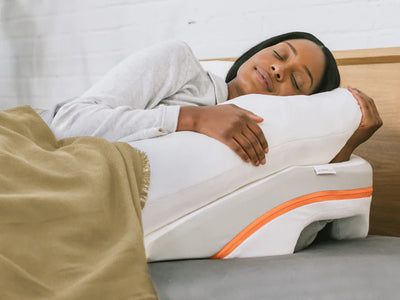
Related Product

Reflux Relief System
$249.99 USD
Say goodbye to nighttime Acid Reflux & GERD pain without sacrificing comfort.
Sleeping Sitting Up: Is It Good for Your Health?
Share
Finding the best sleeping position for your individual body is often easier said than done, and you might not even stick to just one. Beyond your own comfort, there are pros and cons for each style of sleeping. Sleeping on your stomach, for example, can cause nerve issues and back pain, but sleeping on your side or back may bring about other concerns.
What about sleeping sitting up—is it bad or good for your health? In this post, we’ll discuss the benefits and drawbacks of sleeping upright, answer some FAQs, and more.
Read on for a full explanation or use the links below to skip ahead to the section that best answers your query.
- Is it Safe to Sleep Sitting Up?
- Can Sleeping Upright Improve Your Health?
- Sleeping Standing Up
- FAQs
- Is it safe to sleep sitting up?
- Why do I wake up sleeping sitting up?
- What is the healthiest sleeping position?
- Key Takeaways
Is it Safe to Sleep Sitting Up?
In most cases, yes. According to the National Sleep Foundation, sleeping sitting up is safe to do if it’s comfortable and you’re able to get enough sleep. Some individuals may find sleeping sitting up, like in a recliner chair, to be more comfortable than lying down. This can be due to a recent surgery, medical conditions, such as obstructive pulmonary disease, or chronic morbid obesity. Additionally, choosing to sleep sitting up can simply be due to personal preference or necessity, like if you’re trying to fall asleep on a plane seat.

While sleeping upright isn’t necessarily “healthy” or “unhealthy”, there are some considerations to make before committing to an upright sleeping posture. Let’s take a look at how sleeping upright can increase your risk of deep vein thrombosis.

Risk of Deep Vein Thrombosis (DVT)
Next time you’re headed on a long flight and want to catch up on some rest while you’re up in the air, you might want to consider the risk of deep vein thrombosis (DVT). DVT is a kind of blood clot that can form in the veins of your thighs and lower legs after long periods of sitting down with your limbs bent. Severe clots can travel into the lungs and potentially cause a fatal pulmonary embolism.
When you sleep upright on a plane, or just don’t get up to stand for a long time, your risk of developing DVT increases. Additionally, being pregnant, smoking, or taking certain medications can also increase your risk.

Symptoms of DVT can include:
- Red-flushed skin
- Pain or swelling near the clot
- Warmth and tenderness near the affected vein

To reduce your risk of DVT while sleeping on an airplane, use these guidelines:
- Stand up and stretch every once in a while
- Recline your seat if possible
- Stay hydrated
Can Sleeping Upright Improve Your Health?
According to the National Sleep Foundation, sleeping upright isn’t necessarily a healthy or unhealthy choice. However, it can be extremely difficult to do, given the different stages of sleep, especially in REM sleep.
In REM sleep, your body goes through a phase of temporary paralysis, which can make it hard to maintain an upright posture and also get a good night’s sleep.
Sleeping Standing Up
What about sleeping standing up? Can it be done, and is it healthy? Sleeping standing up is incredibly difficult for humans to do, primarily because of the temporary sleep paralysis we discussed above. However, many animals do sleep standing up. This is thanks in part to a “stay apparatus”, which allows them to lock their legs into place without straining their muscles.
The ability to sleep while standing up is also a product of evolution—the posture allows animals, like horses and cattle, the ability to flee faster if a predator arrives while they are sleeping. While these animals are able to catch up on some rest while standing, they’re not able to get REM sleep in this posture, which means they’ll also sleep in other positions as well.
FAQs
Is it dangerous to sleep sitting up?
Sleeping upright is generally safe to do, especially if it’s not for a long period of time. However, sitting still for extended periods can increase your risk of developing a deep vein thrombosis clot. To reduce your risk, recline your seat, drink plenty of fluids, and stand up and stretch when possible.
Why do I wake up sleeping sitting up?
In some cases, you may not fall asleep sitting up, but you end up waking up sitting upright. According to the American Sleep Association, this could be due to something called parasomnias. Parasomnias are disruptions during sleep that may cause an individual to have nightmares, sleep talk, sleep walk, or thrash around throughout the night.
Waking up in a seated position can also be attributed to REM Behavior Disorder (RBD), which causes individuals to act out dreams while they sleep. This can include sitting up, punching, kicking, grabbing, flailing, jumping, and leaping.
What is the healthiest sleeping position?
It depends. Every person is unique and what feels comfortable to one person may not feel great to the next. Here are a few considerations to keep in mind when choosing the right sleeping position for you:
- If you struggle with back or shoulder pain, try sleeping on your back to take pressure off of your shoulder and distribute weight evenly across your spine. Or, try a specialized side-sleeping pillow to alleviate shoulder pain. Our Shoulder Relief System helps take pressure off of your downside arm and allows it to rest comfortably in the built-in arm pocket.
- If you snore or have sleep apnea, try sleeping on your side to minimize the frequency and severity. Additionally, individuals with sleep apnea may consider treatment options, like using a CPAP machine.
- If you have nighttime acid reflux, physicians recommend sleeping on your left side with your torso elevated. This position uses gravity and the natural curvature of your intestinal tract to help reduce heartburn symptoms while you’re sleeping. Our Reflux Relief System uses this same methodology to help you sleep more comfortably with acid reflux. In fact, 93% of MedCline users report a reduction in nighttime heartburn.
- If you are pregnant, it is recommended that you sleep on your side to promote sufficient blood flow to the fetus.
Key Takeaways
- Sleeping upright isn’t good or bad for your health. If you find that you sleep comfortably and are able to get good quality rest sleeping sitting up, go for it!
- If you do choose to sleep upright on a plane, train, or in a car, take steps to minimize your risk of DVT. This type of blood clot can occur when you spend long periods of time sitting down with your limbs bent. To minimize your risk, stay hydrated and make it a point to move around every so often.
- The best sleeping position varies from person to person. When selecting the ideal sleeping posture for you, consider the quality of your sleep as well as how the posture affects you physiologically.
If you struggle with nighttime heartburn or shoulder pain, MedCline can help. Our Shoulder Relief and Reflux Relief Systems are designed to improve the quality of your sleep. Speak to a Sleep Specialist or visit our FAQ page to learn more.
Related Product

Reflux Relief System
$249.99 USD
Say goodbye to nighttime Acid Reflux & GERD pain without sacrificing comfort.



